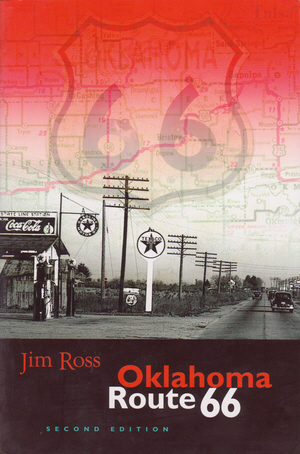 I like this book so much that I have three copies of it. Well, maybe not three exactly but more than two. I got my first in 2007 in anticipation of an Oklahoma trip. It didn’t take me long to discover that the copy was flawed and it didn’t take much longer for a replacement to be provided. A printing error had caused many pages of that first copy to be omitted, duplicated, or otherwise jumbled. The replacement, with all pages present and in the right place, was quite an improvement. This second edition is also an improvement though not that drastic. With it’s accidental mishmash of pages, that first copy was essentially unusable. Every other copy of first edition Oklahoma Route 66 was eminently usable. The second edition is even more so.
I like this book so much that I have three copies of it. Well, maybe not three exactly but more than two. I got my first in 2007 in anticipation of an Oklahoma trip. It didn’t take me long to discover that the copy was flawed and it didn’t take much longer for a replacement to be provided. A printing error had caused many pages of that first copy to be omitted, duplicated, or otherwise jumbled. The replacement, with all pages present and in the right place, was quite an improvement. This second edition is also an improvement though not that drastic. With it’s accidental mishmash of pages, that first copy was essentially unusable. Every other copy of first edition Oklahoma Route 66 was eminently usable. The second edition is even more so.
The book’s organization is essentially unchanged from the first edition, Michael Wallis’ “Introduction” has been replaced by a “Foreword” written by Jerry McClannahan and Ross’ own lead in, which was once called a “Foreword”, is now a “Preface”. But, as Shakespeare might say, an introduction by any other name would still introduce and both Jerry and Jim do just that. Jerry helps to establish Jim’s credentials in a fun to read couple of pages then Jim fills in a little of the space between the two editions. He also explains, just as he did in the first edition, that this is literally a book about the road. Roadside attractions and Route 66 personalities are not entirely ignored but they are secondary. The route itself is the book’s focus.
Where did it go and when did it go there?
Jim Ross is really good at digging out answers to that question as well as communicating them. It is in communicating the route’s changing course that this edition’s biggest single change, color, really pays off. As Ross says himself in that preface, it is “…nice for the photos, but especially helpful with the maps.” Photos and other images are used extensively throughout the book. Some are newly acquired and in color though many are the same ones that appeared in the previous edition but now printed in color where applicable.
I don’t believe that any maps have been added to this edition though many have been revised to reflect changes on the ground or better understanding of past alignments. There are, of course, quite a few “past alignments” to be dealt with. In the earlier edition, dealing with them meant annotations on black and white maps. It worked. The information was certainly there and it could be extracted with a little reading and thought but it is so much easier when a green line marks the original alignment and other colors mark later alignments.
The maps appear in a section titled “The Tour”. It follows those introductions and short sections on the road’s history and construction and an explanation of the maps. “The Tour” is the heart of the book and it does indeed serve as a guide for an east to west tour of Historic Route 66 all the way through Oklahoma. Driving instructions are for what Ross calls a “through” route. This means that dead-ended abandoned stretches are not included. They are shown on the maps, however, and described in the text so someone set on finding every possible inch of Sixty-Six can do so. The text also describes the communities along the route and some of the landmarks in between and it usually provides some interesting history on those communities and landmarks including some that no longer exist. The tour is well illustrated with photos and other images and they are not just filler. Ross is as well known as a photographer as he is an historian. His own current photos are mixed with some by others and quite a few historic ones from various archives. “The Tour” of Oklahoma Route 66, even in an armchair, is far from boring.
Oklahoma Route 66 second edition, Jim Ross, Ghost Town Press, October 2011, paperback, 9 x 5.9 inches, 220 pages, ISBN 978-0967748177
Available through Amazon.
